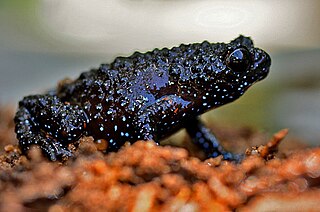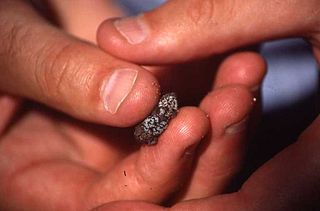
Nectophryne is a small genus of true toads with only two species. They are native to West and Central Africa: Nigeria, Cameroon, Gabon, northeastern Congo, Bioko and Equatorial Guinea. Nectophryne afra uses small bodies of water to lay its eggs which are then guarded by the male.

Melanobatrachus is a genus of narrow-mouthed frogs in the family Microhylidae. It is the only remaining genus in the monotypic subfamily Melanobatrachinae. Two African genera, HoplophryneBarbour & Loveridge, 1928 and ParhoplophryneBarbour & Loveridge, 1928, that were previously placed in this subfamily are now in a subfamily of their own, Hoplophryninae. It contains a single species, Melanobatrachus indicus, also known as the Indian black microhylid frog and Malabar black narrow-mouthed frog. It is endemic to wet evergreen forests of southern Western Ghats in Kerala and Tamil Nadu states of India. It has been recorded from Anaimalai, Munnar, Palni hills, Periyar Tiger Reserve and Kalakkad Mundanthurai Tiger Reserve

Rhinella achalensis is a species of toad in the family Bufonidae that is endemic to northern Argentina.
The Beira toad, or Beira pygmy toad, is a species of toad in the family Bufonidae from southern Africa.
Poyntonophrynus damaranus is a species of toad in the family Bufonidae. This species was previously known as Bufo damaranus, which is now considered a synonym. This anuran is endemic to Kaokoveld-Waterberg in area of northern and northwestern Namibia. The validity of this species has been questioned.
Poyntonophrynus dombensis is a species of toad in the family Bufonidae. It is found in southwestern Angola and northwestern Namibia.
Poyntonophrynus hoeschi is a species of toad in the family Bufonidae. It is endemic to west-central Namibia. Its natural habitats are very dry semi-desert areas near rock outcrops. It breeds in temporary rock pools.
Poyntonophrynus parkeri is a species of toad in the family Bufonidae. It is found in central Tanzania and in southwestern Kenya, from the Usangu Plain in the south northward to the southern Great Rift Valley, Kenya. It is a poorly known species, however, and its distribution might be broader.
Sclerophrys urunguensis is a species of toad in the family Bufonidae. It is found in the border area of Tanzania and Zambia, near the southeastern corner of Lake Tanganyika. One recent Tanzanian record is from close to the border with Burundi. Morphological characters suggests that it actually belongs to the genus Poyntonophrynus, but the formal move to that genus has not been made. Common name Urungu toad has been coined for it.

Poyntonophrynus vertebralis is a species of toad in the family Bufonidae. It is found in South Africa, Lesotho, and possibly Botswana and southeastern Zimbabwe. It has many common names: pigmy toad, pygmy toad, flat toad, African dwarf toad, and southern pygmy toad.

Mertensophryne is a genus of true toads. They are found in eastern and southern Democratic Republic of Congo to Kenya, Tanzania, Malawi, southeastern Zimbabwe, and adjacent Mozambique. Their common names include snouted frogs, Chirinda forest toads, and forest toads. The genus is named for Robert Mertens, German zoologist and herpetologist.
The golden banana frog, golden dwarf reed frog, golden spiny reed frog, or golden leaf-folding frog is a species of frog in the family Hyperoliidae. It is found in lowland coastal plains of eastern South Africa, Swaziland, and southern Mozambique. The AmphibiaWeb includes Afrixalus crotalus in this species as a subspecies, whereas the Amphibian Species of the World and the IUCN Red List of Threatened Species treat A. crotalus as a full species.
Callixalus is a genus frogs in the family Hyperoliidae. It is monotypic, being represented by a single species, Callixalus pictus. It is found in the eastern Democratic Republic of the Congo and western Rwanda. It is sometimes known as the African painted frog.
Hyperolius bocagei is a species of frog in the family Hyperoliidae. It occurs in an area spanning from Angola and northwestern Zambia through southern Democratic Republic of the Congo to southwestern Tanzania. It lives in seasonally flooded, lowland grassy pans. It may suffer localized habitat loss and degradation, but is not considered threatened overall.
Limnonectes namiyei is a species of frog in the Dicroglossidae family. It is endemic to the Okinawa Island, Japan. It is named after Motoyoshi Namiye, a Japanese naturalist and herpetologist. Its common name is Okinawa wart frog or Namiye's frog; the latter name is also spelled Namie's frog.
Ptychadena tournieri is a species of frog in the family Ptychadenidae. It is a widespread species in West Africa and found in Senegal, Gambia, Guinea-Bissau, Guinea, Sierra Leone, Liberia, and Ivory Coast, as well as in Togo and Benin; it is assumed to occur in Ghana and southeastern Burkina Faso, although it has not been recorded there. On the other hand, some records may refer to other species; the Amphibian Species of the World excludes Gambia and Togo from the distribution. Common names Liberia grassland frog and Tournier's rocket frog are sometimes used.

The Tandy's sand frog is a species of frog in the family Pyxicephalidae. It is found in South Africa, Botswana, Namibia, and southwestern Angola, and from the inland Tanzania and Kenya. It probably occurs more widely within and between these two disjunct areas. The specific name tandyi honours Robert Mills Tandy, an American biologist, herpetologist, and photographer and the collector of the type material.
Leptopelis spiritusnoctis is a species of frog in the family Arthroleptidae. It is found in West Africa from Guinea to the Niger Delta in Nigeria, the intervening countries being Sierra Leone, Liberia, Ivory Coast, Ghana, Togo, and Benin. This species was previously known as Leptopelis hyloides, but that name is actually a junior synonym of Leptopelis viridis.

Poyntonophrynus, also known as pygmy toads, are a genus consisting of ten true toad species native to Sub-Saharan Africa. Originally, all Poyntonophrynus species were included in the genus Bufo. The genus was split due to large enough taxonomic divergence as evidenced by molecular markers. The genus is named in honour of John C. Poynton, South African herpetologist, with phrynus being Greek for toad.

Poyntonophrynus fenoulheti is a species of small toad found in southern Africa. It is known under many common names, including Fenoulhet's toad, Fenoulhet's pygmy toad, and northern pygmy toad. It grows to a maximum size of 43 mm.







